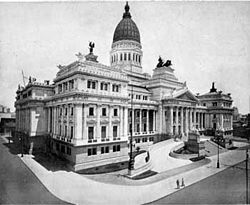Architecture of Argentina
This articlepossibly containsoriginal research.(August 2007) |
| Part ofa serieson the |
| Culture of Argentina |
|---|
 |
| Society |
| Topics |
| Symbols |
|
|
Thearchitecture ofArgentinacan be said to start at the beginning of theSpanish colonisation,though it was in the 18th century that the cities of the country reached their splendour. Cities likeCórdoba,Salta,Mendoza,and alsoBuenos Airesconserved most their historicalSpanish colonial architecturein spite of their urban growth.
History
[edit]
The simplicity of theRioplatenseBaroque stylecan be clearly appreciated in Buenos Aires, in the works of Italian architects such as André Blanqui and Antonio Masella, in the churches ofSan Ignacio,Nuestra Señora del Pilar,theCathedraland theCabildo.
Italian and French influences increased after thewars for independenceat the beginning of the 19th century, though the academic style persisted until the first decades of the 20th century. Attempts at renovation took place during the second half of the 19th century and beginning of the 20th, when the European tendencies penetrated into the country, reflected in numerous important buildings of Buenos Aires, such as the Santa Felicitas Church by Ernesto Bunge; theCentral Post OfficethePalace of Justice,byNorbert Maillart;theNational CongressbyVittorio Meanoand theColón Opera House,byFrancesco Tamburini.
A number of young Italian architects, includingVirginio Colombo,Francisco GianottiandMario Palantiwho designed the Italian pavilion for theExposición Internacional del Centenario (1910),went on to establish successful careers in Buenos Aires working in a number of styles, includingArt Nouveau.Their buildings were some of the most important of the 20th century in Buenos Aires and those that remain continue to play a significant role in defining the city's architectural landscape.
The architecture of the second half of the 20th century continued adapting Frenchneoclassical architecture,such as the headquarters of theNational Bank of Argentinaand theNH Gran Hotel Provincial,built byAlejandro Bustillo,and theMuseo de Arte Hispano Fernández Blanco,by Martín Noel.
However, after the early 1930s, the influence ofRationalist architectureand ofLe Corbusierbecame dominant among local architects, among whomAlberto PrebischandAmancio Williamsstand out in this new vein. The construction ofskyscrapersproliferated in Buenos Aires after 1950, though a new generation started rejecting their "brutality," and tried to find an architectonic identity.
This search for identity is reflected in theBanco de Londres buildingfinished in 1967 byClorindo Testawith Diego Peralta Ramos, Alfredo Agostini, and Santiago Sánchez Elía. In the following decades, the new generations of architects incorporate, as always, European vanguardist styles, and new techniques.

Since the latter part of the 20th century, Argentine architects have become more prominent in the design of prime real estate projects in the country, such as theLe Parc towerandTorre Aqualina,byMario Roberto Álvarez,and the Torre Fortabat by Sánchez Elía, as well as around the world, most notably theNorwest Centerand thePetronas Towers,both byCésar Pelli.
Argentine neighborhoods are characterized by highly independent designs for each building. Most houses have individual designs. Tract housingis near to non-existent, generally reserved for subsidized houses made by the state for the poorest.
See also
[edit]- List of tallest buildings in Argentina
- Kavanagh Building
- Mar del Plata style
- Casa Argentina del Arte Correo
Gallery
[edit]-
Neo-RenaissanceColón Theatre,Buenos Aires
-
Beaux-ArtsClub Argentino,Bahía Blanca
-
Eclectic stylePalacio de Aguas Corrientes,Buenos Aires
-
Art NouveauBarolo Palace,Buenos Aires
-
Art DecoKavanagh Building,Buenos Aires
-
RationalistAlas Building,Buenos Aires
-
BrutalistArgentine National Library,Buenos Aires
-
Casa Chorizo,Buenos Aires
References
[edit]External links
[edit]![]() Media related toArchitecture of Argentinaat Wikimedia Commons
Media related toArchitecture of Argentinaat Wikimedia Commons














